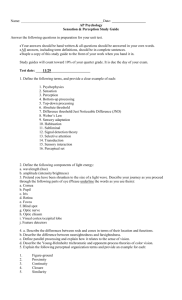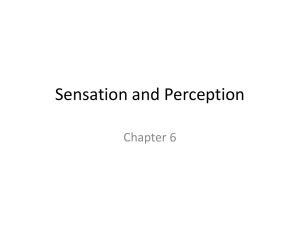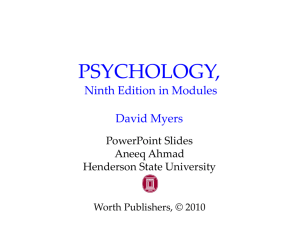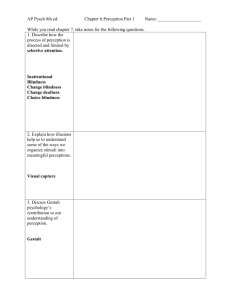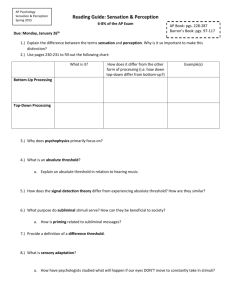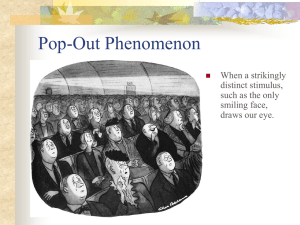Perceptual Organization
advertisement
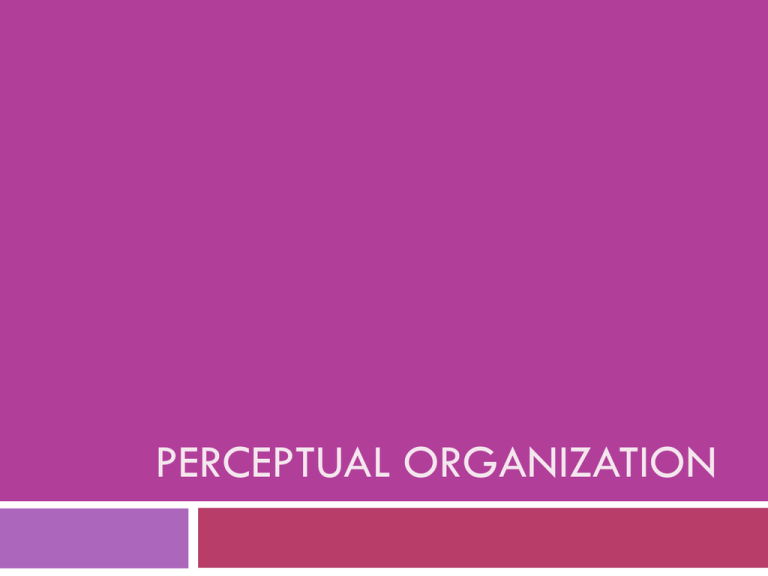
PERCEPTUAL ORGANIZATION When we are given a cluster of sensations, we organize them into a “gestalt” or a “whole” “The whole is greater than the sum of the parts.” We take in sensory information and infer a perception that makes sense to us based on our past experiences. What is a Figure/Ground Relationship? Discriminate the focus of stimulus from the background. One stimulus can trigger more than one perception. How Do We Organize Stimuli Into a Meaningful Form? Our mind has “Rules” for Grouping 1. Proximity 2. Similarity 3. Continuity 4. Connectedness 5. Closure Examples of Grouping Examples of Grouping DEPTH PERCEPTION Seeing things in 3 dimensions—but we only have a 2-dimensional retina Both an innate (born with it) and a learned skill Utilizes both “binocular” clues and “monocular clues” Visual Cliff Experiment Binocular Clues Retinal Disparity Our eyes are about 2 ½ inches apart Provides an important clue to the relative distance between 2 objects Retinal disparity is greatest directly in front of your face Let’s Make Finger Sausages! 3D Movies Increase Retinal Disparity! It’s More Difficult to Judge Distant Objects Much less retinal disparity We depend on monocular depth clues 1. Relative height 2. Relative size 3. Linear perspective 4. Light and shadow 5. Interposition 6. Relative Motion We Depend on Monocular Clues 1. Relative height: We perceive object higher in our visual field as being further away. We Depend on Monocular Clues But… We Depend on Monocular Clues 2. Relative Size: If we assume that 2 objects are roughly the same size, we perceive the one that “looks” smaller (casts a smaller retinal image) to be further away We Depend on Monocular Clues 3. Linear Perspective: The more parallel lines converge (come together), the greater their perceived distance. We Depend on Monocular Clues 4. Light and Shadow: Nearby objects reflect more light to our eyes. If 2 objects identical in shape and size, the dimmer one appears further away. Also, our brain “assumes” that light comes from above. We Depend on Monocular Clues 5. Interposition: If one object blocks the view of another, we perceiving the “blocking” object as being closer. We Depend on Monocular Clues 6. Relative Motion: If we ourselves move, objects that are actually stable may appear to move. Let’s Review Depth Perception Reviewing Depth Perception MOTION PERCEPTION Shrinking objects are retreating Enlarging objects are approaching Large objects appear to move slower than smaller objects moving at the same speed Tennis Shoe and Batteries Motion Perception Stroboscopic Movement Motion Perception Phi Phenomenon Phi Phenomenon PERCEPTUAL CONSTANCY How we recognize objects without being deceived by changes in their: Shape Size Brightness Color Shape Constancy Shape Constancy But we can be fooled Size Constancy Size Constancy But we can be fooled… Color & Light Constancy Light Constancy But we can be fooled… 6.5.4 Perceptual Constancy PERCEPTUAL INTERPRETATION Life experience has a huge impact Perceptual Adaptation Can we change how we perceive? Perceptual Set Emotions, expectation, and context ALL influence our perceptions The Brain is a Great ‘Face Detector’ It’s All About Context Even Culture Influences Context
